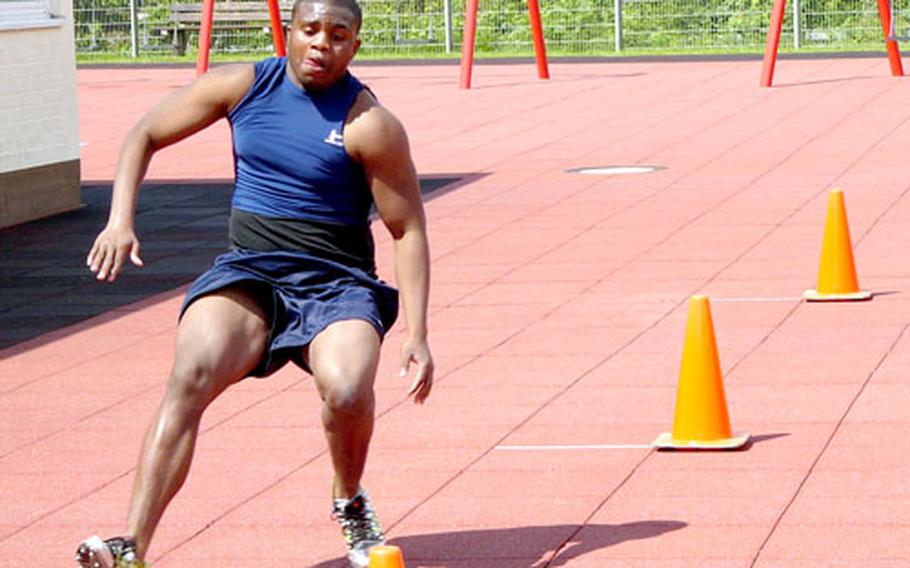
Heidelberg’s Quentellas Wynn prepares to reverse direction during the 20-yard shuttle run at Saturday’s DODDS-Europe Sports Combine at Heidelberg, Germany. (Rusty Bryan / S&S)
HEIDELBERG, Germany — Thirty-three high-schoolers who hope to play college football took what could be the first step Saturday at the first DODDS-Europe Sports Combine.
The combine allowed the athletes to establish official times and distances in events that college coaches use to evaluate prospects — 40-yard dash, 20-yard shuttle run, three-cone drill, bench press repetitions at 155 or 185 pounds, and standing broad and vertical jumps.
In addition, each participant’s height, weight, body-fat percentage and flexibility mark, along with an individual photograph, were posted on a database for college coaches to scan.
“We’re here to create some opportunities for these kids,” said Ansbach coach Marcus George, director of the combine, which was staffed by DODDS-Europe coaches and volunteer assistants. “The times they establish here will add some credibility to their resumes, and they can see exactly how they match up with stateside combines.”
The athletes understood the need to do well.
“It’s a great way to get players noticed,” said Ramstein’s Marcus Cherry as he prepared to tackle the 20-yard shuttle run, a drill that measures how quickly a candidate can move in one direction and then reverse his field. “Players over here don’t get seen as often [by scouts and coaches] as players in the States.”
George told the participants that their numbers would help solidify their credentials with college coaches trying to decide whether to offer the player a scholarship.
“A coach might see you on film and be told you’re a good athlete,” he said. “With the combine data, he can see exactly how you measure up against other prospects.”
Although the combine was a first for DODDS-Europe, the drills were old hat for some.
“I went to a combine in the States last year,” Bitburg running back Anton Harris said as he prepared for the first of his allotted two cracks at the 40. “There were about 500 kids there.”
Harris clocked 4.75 in his first effort in training shoes on the course’s rubberized tiles. According to figures given to each participant, 4.75 put Harris in the 80th percentile of high school running backs nationwide.
“I’ve run 4.5,” Harris said. “I’d rather run in cleats.”
Top time in Saturday’s 40 was a 4.53 run by Ansbach junior-to-be Dominique Whaley, the European 100-meter champion who also posted the day’s best shuttle run, 4 seconds flat. Both figures landed him in the 95th percentile of high school running backs, but Whaley saw room for improvement.
“I could have done better,” he said. “I’ve just got to push harder.”
George, who’s considering conducting another combine at the annual DODDS-Europe football camp scheduled for Ansbach in August, emphasized that point.
“You can prepare for the combine,” he told the group. “There’s a technique to every drill. With research and practice, you can improve your technique and your score.”
The combine concluded with the compilation of individual portfolios for each athlete and lectures to the athletes and parents about academic requirements, rules governing contacts with colleges and information about the NCAA Clearinghouse, a body which oversees all Division I and II student-athletes.
“It’s a good learning tool,” said Jimmy Anderson of Heidelberg while watching his son Justin, a senior linebacker, run the 40. “It’s like training them up from high school to college ball.”